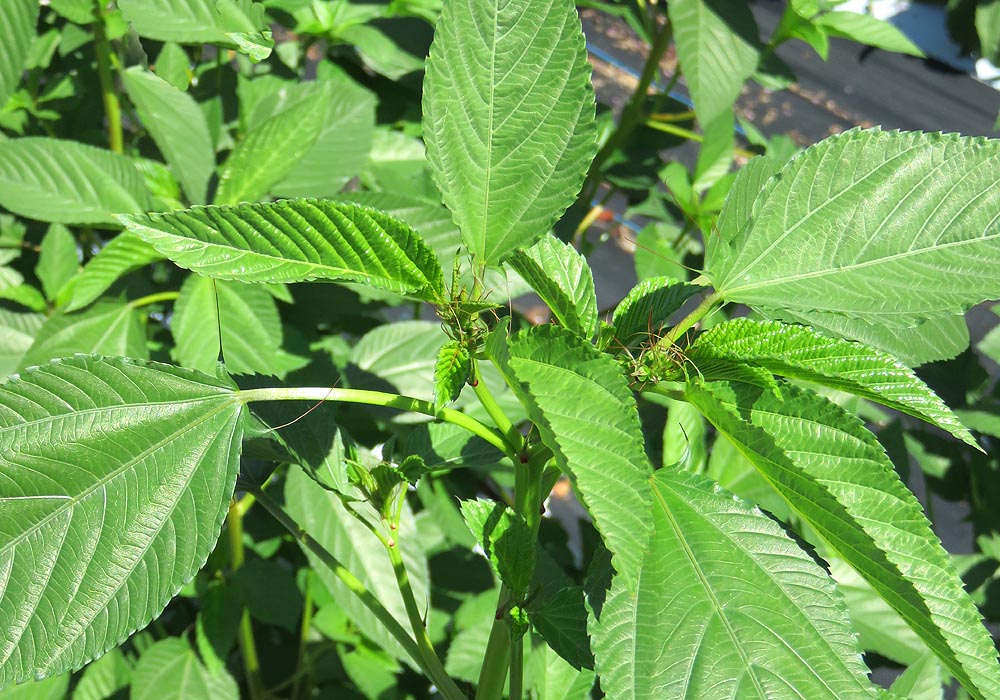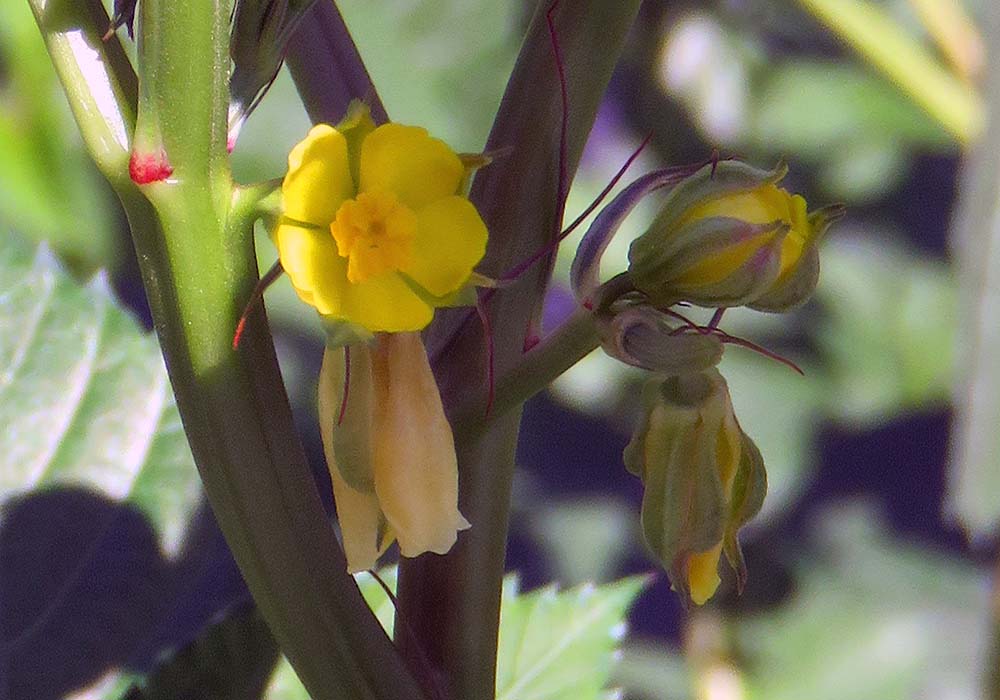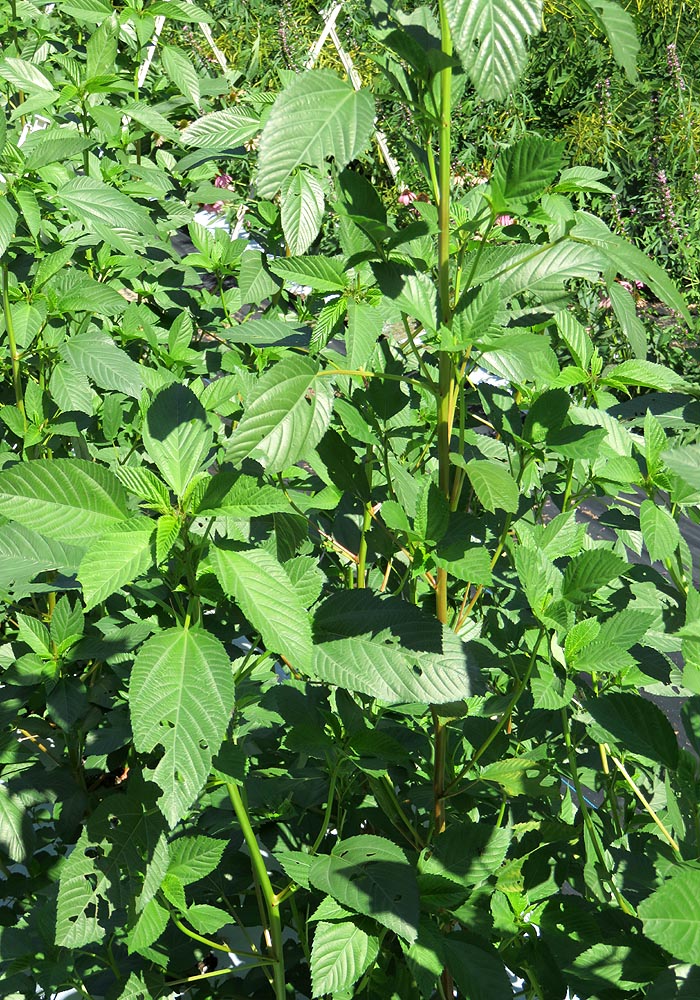Lesser known in Western Countries jute is a major food source in many areas of the world. It's the most consumed vegetable in Egypt. A tropical plant that does well here in hotter sunny regions jute is grown for its fresh green leaves that can be eaten in soups and stews. It's not really a substitute for spinach as it has mucilaginous properties when cooked but its extremely nutritious, high in protein and many vitamins and very easy to grow. If you like leafy greens you may want to give it a try. Unharvested jute can grow to over 12 feet in height but as fresh green leaves are constantly collected several plants can supply a household with greens all growing season. Plus leaves can be harvested and dried for winter use. The issue may be ensuring you eat it as fast as it can grow, since it grows fast. Seeds are an unusual bluish green pyramid shape. May need staking if not harvested fast enough. Unsure if wildlife will eat it.
Description of Jute or Egyptian Spinach (Corchorus olitorius).
A tropical annual herb that can be easily grown in most parts of the US from zone 6 south. In hot areas left uncut it can grow up to 12 feet (3 to 3.6 m) in height. In cooler zones it usually grows to about half that. It has a strong upright cylindrical stalk that can be more than an inch (2.5cm) in diameter. The leaves are medium bright green up to 6 inches (15.2cm) long and 2 inches (5cm) wide mostly Lanceolate in shape with serrated edges and deep cut veins giving leaves a very textured appearance. Each leaf also has a pair of fine down pointing tendrils that emerge from the base of the leaf and can be quite long. The tendrils are the first to grow and often tiny leafs emerging from the node are overshadowed by their long tendrils making nodes appear like a mass of small fibers. Flowers also emerge in clusters from the leaf nodes in the upper portions of the plant. These are small about 0.5 inches (1.27cm) in diameter and consist of five separated bright yellow petals obovate in shape that surround a large cluster of yellow stamens surrounding the central stigma. Flowers are followed by long narrow seed pods that are deeply ridged and can reach 4 inches (10cm) long and 0.5 inches (1.27cm) wide. Seeds are small roughly triangular in shape and greenish blue in color. Plants will grow until frost kills them.
Growing Jute or Egyptian Spinach (Corchorus olitorius) from Seed.
Being a tropical plant it needs heat so is best started indoors in all zones above 8. Not recommended for zones 5a and above as most likely won't get enough heat.
Start indoors in mid to late winter. Start seeds in small pots or plug trays if possible. Seeds are naturally a greenish blue color they are NOT treated. Keep in warm location over 70F (21C) is best. Pot on and grow inside until all danger of frost is past then transplant to a warm sunny location. For more information on growing from seed see our General Growing Instructions.
If intending to harvest whole plants sowing will need to continue throughout the growing season to replace harvested plants. Can be direct sown when summer heat is consistently high but may still take longer to produce than if started inside.
Location and Care of Jute or Egyptian Spinach (Corchorus olitorius)
Must have full sun in a warm location. Will grow tall if not continuously harvested so consider location as it will overshadow other rows and may need staking in areas that get intermittent high winds from storms.
Prefers a well drained rich soil. Best to add a good amount of organic material / compost to the bed before planting. Put transplants in ground as early as possible after frost has past; even in zone 7b early planting is required if flowering is desired. Later planting and the plants will not flower but will produce masses of useable leaves.
Needs continual water for best results. A soaker hose along the base of the plant row is an ideal solution as plants soon get very tall and it is difficult to water without spraying leaves which is undesirable. Space plants anywhere from 12-24 inches (30.5-61 cm) with at least 4 feet (1.2m) between rows. Be prepared to stake plants. In areas where there are constant breezes plants usually become strong enough, but areas where there is often little wind until a thunderstorm comes through the plants may not be strong enough and may bend over. If growing for leaf harvest plants may not reach heights that need staking.
The fact that this plant has so many 'other names' - see below for just a few of them shows how popular around the world this vegetable is. It is mostly used in soups, stews and other cooked items that need thickening. It cannot be used as a substitute for western spinach despite the name because it's a cousin of the okra and like okra it contains mucilage. In other words it gets slimy when its cooked so most spinach recipes would be ruined unless it's a soup or stew.
However it can be used as a thickener in these dishes and is very nutritious, more so than spinach especially for those with stomach issues where the mucilage is very beneficial. Its also a lot easier to grow in warmer climates than spinach.
Leaves can be dried for later use or pounded into flour and stored for long periods for later use.
Tinctures of the seeds have been shown to have very broad and strong antibacterial effects. Taken as just seeds in higher amounts they act as a purgative
Smaller fibers are also used to make strong paper.
Plus at least 50 more in different languages.








